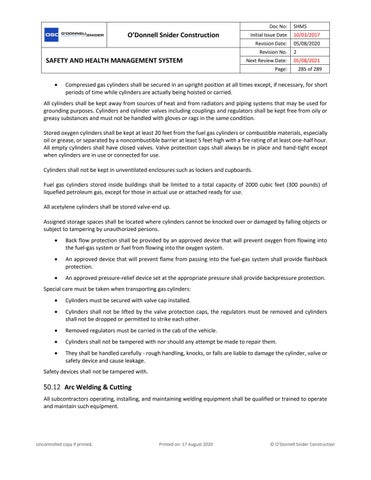Doc No:
O’Donnell Snider Construction
Initial Issue Date
10/03/2017
Revision Date:
05/08/2020
Revision No.
SAFETY AND HEALTH MANAGEMENT SYSTEM
Next Review Date: Page:
•
SHMS
2 05/08/2021 285 of 289
Compressed gas cylinders shall be secured in an upright position at all times except, if necessary, for short periods of time while cylinders are actually being hoisted or carried.
All cylinders shall be kept away from sources of heat and from radiators and piping systems that may be used for grounding purposes. Cylinders and cylinder valves including couplings and regulators shall be kept free from oily or greasy substances and must not be handled with gloves or rags in the same condition. Stored oxygen cylinders shall be kept at least 20 feet from the fuel gas cylinders or combustible materials, especially oil or grease, or separated by a noncombustible barrier at least 5 feet high with a fire rating of at least one-half hour. All empty cylinders shall have closed valves. Valve protection caps shall always be in place and hand-tight except when cylinders are in use or connected for use. Cylinders shall not be kept in unventilated enclosures such as lockers and cupboards. Fuel gas cylinders stored inside buildings shall be limited to a total capacity of 2000 cubic feet (300 pounds) of liquefied petroleum gas, except for those in actual use or attached ready for use. All acetylene cylinders shall be stored valve-end up. Assigned storage spaces shall be located where cylinders cannot be knocked over or damaged by falling objects or subject to tampering by unauthorized persons. •
Back flow protection shall be provided by an approved device that will prevent oxygen from flowing into the fuel-gas system or fuel from flowing into the oxygen system.
•
An approved device that will prevent flame from passing into the fuel-gas system shall provide flashback protection.
•
An approved pressure-relief device set at the appropriate pressure shall provide backpressure protection.
Special care must be taken when transporting gas cylinders: •
Cylinders must be secured with valve cap installed.
•
Cylinders shall not be lifted by the valve protection caps, the regulators must be removed and cylinders shall not be dropped or permitted to strike each other.
•
Removed regulators must be carried in the cab of the vehicle.
•
Cylinders shall not be tampered with nor should any attempt be made to repair them.
•
They shall be handled carefully - rough handling, knocks, or falls are liable to damage the cylinder, valve or safety device and cause leakage.
Safety devices shall not be tampered with.
Arc Welding & Cutting All subcontractors operating, installing, and maintaining welding equipment shall be qualified or trained to operate and maintain such equipment.
Uncontrolled copy if printed.
Printed on: 17 August 2020
© O’Donnell Snider Construction

